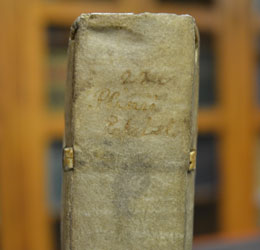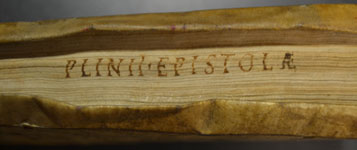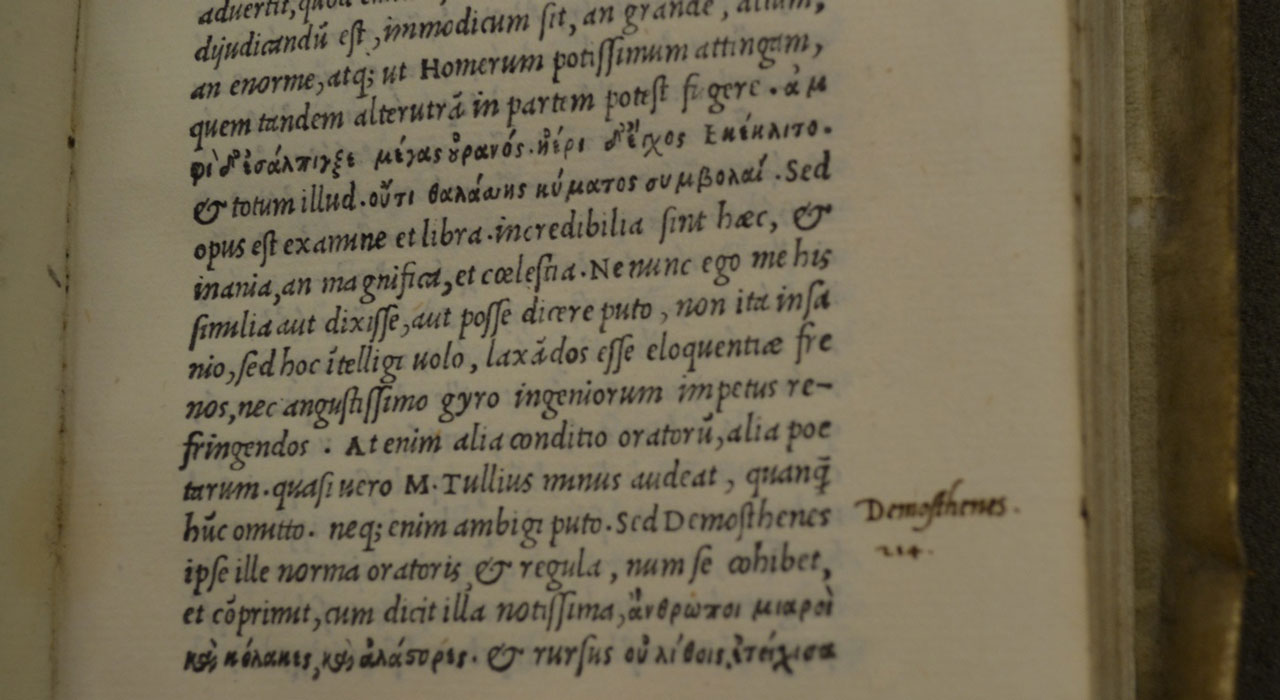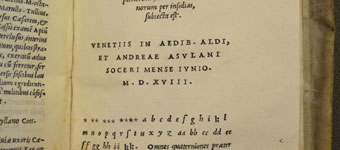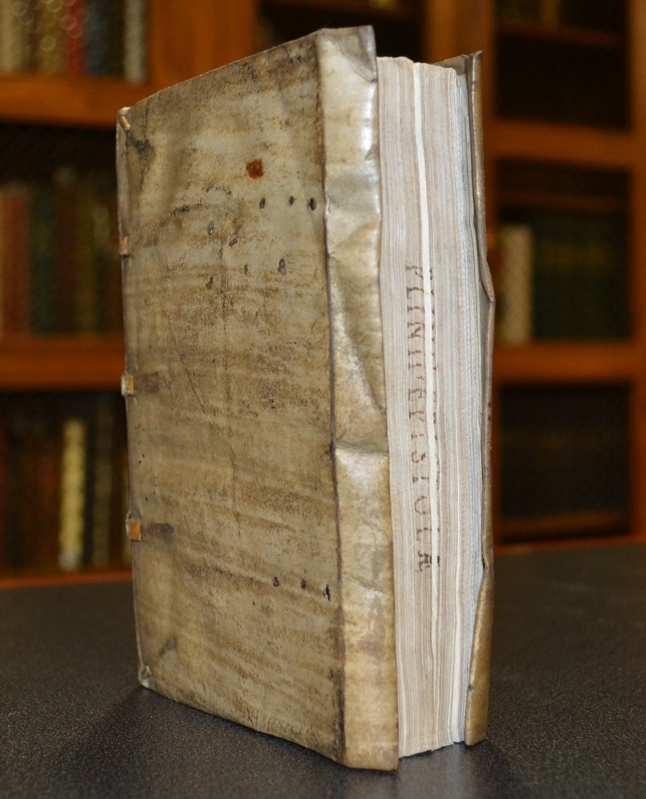
The Special Collection's copy of
C. Plinii Secvndi Novocomensis Epistolarum libri X, C. Plinij Secundi Nouocomensis Epistolarum libri 10, C. Plinii Secundi Novocomensis Epistolarum libri X, Gaij Plinij Secundi Nouocomensis Epistolarum libri X, Epistolarum libri X, De viris illustribus urbis Romae., Suetonij Tranquilli de claris grammaticis & rhetoribus, Iulij Obsequentis prodigiorum liber., De uiris illustrib[us] in re militari & in administranda rep
published by the Aldine Press in 1518.
The Aldine Press was located in Venice and began printing in 1494, forty years after the completion of Gutenberg's bible in 1454. Today, the Aldine Press is known for being one of the most important presses of Europe. Aldus Manutius, the founder of the press died in 1515 and the control of the press passed to his brother-in-law Asolani until Aldus's youngest son, Paulus (Paolo) Manutius took over in 1533.
When Aldus Manutius began the press, printing was fairly well established throughout Europe. Every major country had a press operating within its borders. What makes the Aldine Press important is both the beauty and the quality of the books which they produced and the innovations that made those books unique. The Aldine Press, as it is known today, popularized the smaller format books and introduced, in 1501, italic type.
Nearly all of these innovations can be seen in the Special Collection's edition of Pliny the Younger in Latin printed by the Aldine Press in 1518. Our copy is a second edition of the work, printed when Asolani was in control of the press and edited by A.P. Manuzio
Pliny the Younger was a lawyer, author, and magistrate of Ancient Rome. He is best known for his hundreds of letters, many of which still survive today. He was born sometime around 68 AD and died sometime after 112 AD. Though this volume includes his letters, it also includes several works attributed to Pliny, but whose authors are unknown such as "De viris illustribus" revised by G. B. Egnazio and P. Manuzio.
These small format Latin class editions were a trademark of the Aldine Press, as they were unannotated and fairly inexpensive. Bound in contemporary limp vellum, our copy has both an inscribed fore-edge and an inscribed spine. The 1518 edition of his works is an elegant example of book format in the early 16th century. The volume is small, about the size of a mass market paperback, and in octavo format.
The spine of the book is inscribed with an abbreviated form of the title and author while the fore edge also contains the author and title. The edges of the vellum binding have been folded over the text black to protect it, a technique known as yapp edges.
The spine has been supported by strips of medieval manuscript and the gatherings of pages have been sewn over leather thongs which are tucked into the cover to secure it too the pages. Generally, this style of binding was seen as being temporary and relatively inexpensive, so some scholars' believe it was preferred by students. It is entirely possible that our edition belonged to a student at one time.
Though little is known about the books provenance, throughout the text neat handwritten annotations have been added, sometimes noting a page number or correcting the Latin.
Throughout the book guide letters appear. Back when this book was published, people were still hiring artists to illuminate their books, as had been done in manuscripts. So, the capital letters at the beginning of sections were often printed with space around them so the hired illuminator didn't have to wonder if that word began with a C or a L. They just used the guide-letter. Illumination was expensive though and so it is not uncommon to books with the space, but no lavish illustration around the letters.
In the back of the book, the Aldine Press included their colophon. A colophon is a statement in the back of the text that provided information on the printer, publisher and date of publication. This is how we know our book was published in 1518. While there are larger and certainly more lavish books in the Special Collection, Pliny the Younger was used by someone nearly five hundred years ago to study the classics and that makes it a true treasure.
Rachel Cohen is a former User Engagement Special Collection Librarian for Samford University Library.
Resources
- "Aldine Press." The Encyclopedia of the Renaissance. Aylesbury: Market House Books Ltd, 1987. Credo Reference. Web. 5 June 2014.
- "Pliny the Younger." Science in the Ancient World: An Encyclopedia. Santa Barbara: ABC-CLIO, 2004. Credo Reference. Web. 5 June 2014.
- Carter, John, and Nicolas Barker. ABC for Book Collectors. New Castle, DE: Oak Knoll, 1995. Print.
- Renouard, Ant Aug., and Edmund Goldsmid. A Bibliographical Sketch of the Aldine Press at Venice: Forming a Catalogue of All Works Issued by Aldus and His Successors, from 1494 to 1597, and a List of All Known Forgeries or Imitations ; Translated and Abridged from Ant. Aug. Renouard's "Annals De L'imprimerie Des Aldes" ; Revised and Corrected by Edmund Goldsmid. Edinburgh: E.G. Goldsmid, 1887.
- Pliny, Aldo Manuzio, Suetonius, and Julius Obsequens. C. Plinii Secvndi Novocomensis Epistolarū Libri Decem ... Eiusdem De Viris Illustribus in Re Militari, Et in Administranda Rep. Suetonii Trãquilli De Claris. Grãmaticis Et Rhetorib. Iulii Obsequentis Prodigiorum Liber. Epistolæ Decimi Libri Ad Traianum Probantur Esse Plinii in Sequenti Epistola. Inibi Etiam Liber De Viris Illustribus, Nó Tranqlli, Sed Plinii Esse Oñditur. Venetiis: In Aedib. Aldi, Et Andreae Asvlani Soceri, 1518.


